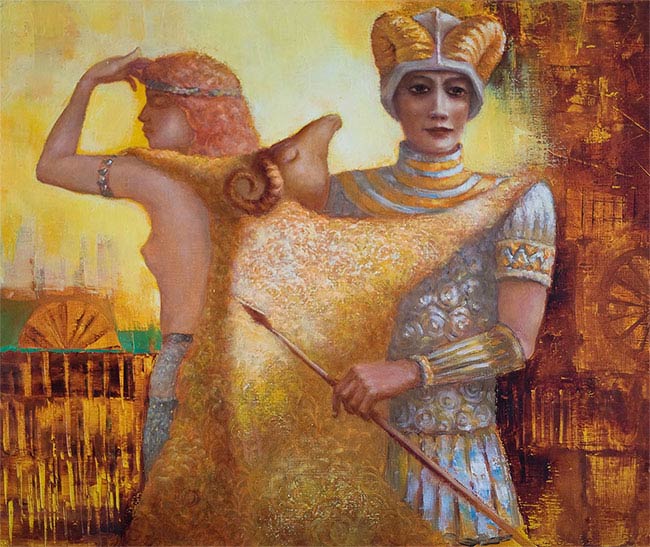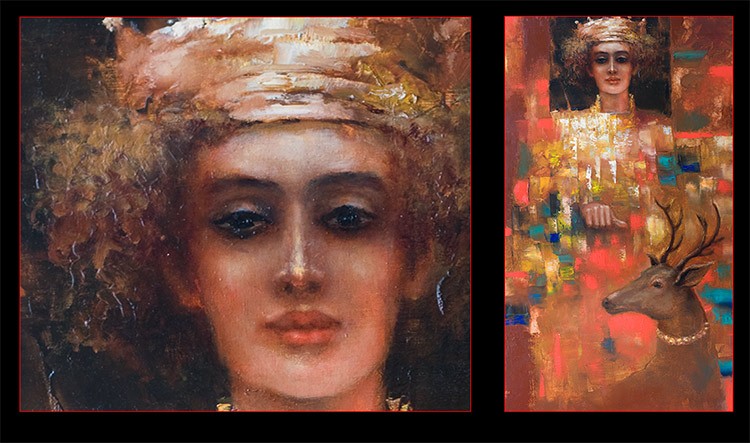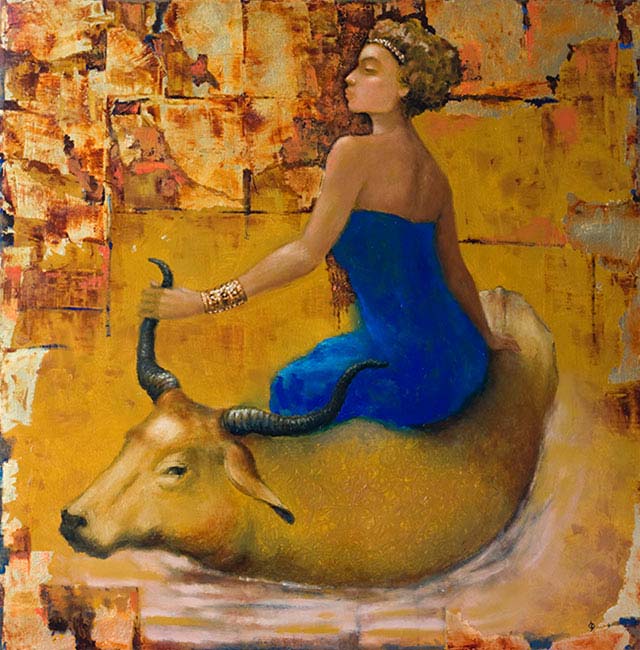Our life is so multifaceted and diverse that it is simply impossible to cover all aspects. However, there is such a wonderful part of it, without which it is difficult to imagine a modern person. It is the oldest and perhaps the most interesting of all aspects of life. These are myths, very diverse and unusual. Today, there are so many variations and types of them that it seems simply impossible to cover them all. However, I tried to do this on the example of the work of Vitebsk artists in 1995-2010.
Hey! This text has been translated into English using automatic Google translation. So I apologize for the inaccuracies in the text. The original in Russian can be seen here
All material is presented in four articles devoted to different directions in modern myths, respectively:
- Religious and mythological themes in the painting of contemporary artists of Vitebsk.
- Biblical subjects in the works of Vitebsk authors.
- Pagan themes in the works of artists of Vitebsk.
- Mythological subjects in the author’s interpretation.
This study was carried out by me in 2009-2010 as part of my master’s thesis “Mythology in the work of contemporary artists of the Vitebsk region”, which was successfully defended in the same year.
Religious and mythological themes in the painting of contemporary artists of Vitebsk.
Myths occupy a large part in the life of every person. A huge proportion of them are religious myths. And it really is. Although someone will say that legends and myths in modern conditions of an urban, scientific and information-saturated society are a relic of the past. But when you look more attentively and deeper into the very essence of every detail of our life, the existence of myths will become quite obvious. After all, they live inextricably linked with each of us. And maybe even more than before. And certainly not to a lesser extent today’s world, society and, accordingly, art and painting depend on myths. You just have to look around and everything will fall into place.

Religious and mythological motifs are that huge layer in which one can easily include myths that have become customs, rituals, and cults. Therefore, mythological plots of all religions of the world are called here. These are Christian, Buddhist, Islamic, and motifs of ancient, pagan religions. For example, such as Greek and Roman, Egyptian and “Eastern” (if we combine under a common name all the myths of the peoples inhabiting the eastern part of Eurasia). There are many such religious myths. And for most of the plots of these myths, at least once the work was done by the artist. Modern art, and in particular painting, as well as in past centuries, constantly refers to religious themes. Today, in the paintings of artists, you can find all the same motifs from ancient and modern sacred mythology. The authors continue to dedicate their works to them, putting a new meaning into well-known stories.

In Vitebsk, one can name quite a few artists who, one way or another, turned to myths, displaying them in their paintings indirectly or directly. But not all of them are addressed to sacred motives. Many modern artists, reworking and changing what they saw and heard, reflect in their works not only specific religious myths, but their combinations and layers, turning the seen plot into their own myth. This is what is understood today as mythological plots in the author’s interpretation. However, among Vitebsk artists, one can list many names of authors who turn specifically to religious and mythological themes. Here are some of them: Sergei Kukhto, Sergei Sotnikov, Oleg Kostogryz, Oleg Zakharevich, Nikolai Dundin, Viktor Shilko, Eduard Galustov, Dmitry Gorolevich, Anatoly Izoitko, Tamara Ababkova. Many of these artists constantly turn to mythological subjects, while others only occasionally.


In general, among the works of Vitebsk authors, written on religious and mythological motifs, several main directions can be distinguished. Due to the geographical location of Vitebsk and the corresponding trends in society, which have a huge impact on people of art, the range of mythological motifs is not very wide. Among them you can see ancient Greek and ancient Roman, Indian, Chinese, Egyptian and under the general name – “oriental” myths. The most frequent motifs that the authors refer to are ancient Greek and ancient Roman.

A classic example of turning to myths are ancient Greek and Roman motifs. The following works can be noted, which were written in the last ten or fifteen years and reflect the views of artists on this topic: Sergey Kukhto “Chiron with the Spartans”; Sergei Sotnikov “Judith”, “Walking with a Unicorn”; Oleg Kostogryz “Argo. The Time of Poseidon”, “Golden Rain”, “The Abduction of Europe”, “Bathing Diana”; Oleg Zakharevich “Icarus”, “Golden Fleece”, “Artemis”, “Helena of Troy”, “The Abduction of Europe”, “Cleopatra”, “Colosseum Fairy”; Nikolai Dundin “Socrates” and other paintings.




For example, on the canvases of the Vitebsk artist Oleg Kostogryz, we see a desire to show oneself as part of the world, to reflect the environment in a kind of mirror of the artist. Myths are projections of life: birth, death, love, hate. And all this can be seen in a variety of mythologies, which the author reflected in his works. Among them are such as ancient Greek and Roman, Babylonian and Indian, Egyptian and Japanese myths. For example, in the work “Golden Rain” we observe the famous story from Greek mythology about how Acrisius was predicted that he would be killed by his daughter’s son, then he imprisoned Danae in an underground copper house and assigned a maid to her. Zeus, captivated by the beauty of the prisoner, penetrated to her in the form of golden rain and their son Perseus was born. The artist in his picture shows us Danae, her maid and the golden rain falling from above directly on the girl. The entire work is written in bright gold, red and green colors. Another story from ancient Greek mythology can be seen in the work “The Rape of Europa”. Zeus fell in love with Europe, the daughter of the Phoenician king Ageron, and kidnapped her, either turning himself into a meek bull, or sending a bull after her. The picture is painted in the same juicy gold and red colors. The author depicted the bull with bright yellow flowers, reminiscent of gold. So the artist shows his divine origin. The composition of the work has a central construction and a dynamic forward movement directly towards the viewer. Kostogryz O. in his paintings often refers to ancient Greek subjects, as evidenced by the above works. The artist tries to convey the main idea of the myth through well-found images that help the viewer to perceive a new interpretation of an already known mythological plot.



A new reading of the old motif is especially relevant today. And on the examples of the work of Kostogryz, you can see this perfectly. The author, using well-known symbols and images, makes up a new compositional solution, which makes us look at the already known myth in a completely different way. Here, for example, as in the painting “Argo. The Time of Poseidon” we see a large face that symbolizes the god Poseidon watching the Argonauts. The Argonauts themselves are presented as a small Greek ship with orange sails. There is no sky in the work, and instead the general background of the picture is successfully found spots of blue and yellow colors, intersecting with the image of Poseidon. All the action takes place in an incomprehensible space, although the viewer immediately understands that the action takes place at sea, because. You can see that the ship is sailing on the sea.

In such works, the authors recreate the world of old myths and legends of ancient Greece and Rome through the transmission of specific images and actions. But not everything here is as clear as it seems at first glance. It would seem that the artists paint separate works in the context of classical Greek mythology, and this is where the problem of myths ends. However, it can be seen that today in painting has its own characteristics. They set the general tone and character of the work. Features are made up of modern styles that are popular in one way or another. For example, Sergei Kukhto in the work “Chiron with the Spartan Women” used the technique of smooth writing along with the realistic construction of the entire composition and registration of details. This allowed the author to convey the incredible feeling of the surf and the centaur walking along the coast with the Spartan women. The same incredible feeling of an ancient myth, when the heroes depicted in the picture “come to life”, is also present in this work. Here the god Pan sits and the nymph dances beside him. The entire composition of the work consists of two figures, one of which is turned back to the viewer. The author deliberately depicts the god sitting with his back in order to better express the character of the hero. This figure is an image of the god of wildlife and cattle breeding. Such a conclusion can be drawn from the goat horns and ears depicted on the figure of the god Pan, hooves instead of legs and an abundance of wool on the body. The author captured all these signs well and conveyed in his picture. Sergei Kukhto uses a smooth brush stroke. He prescribes every hair and other characteristic details on the body of the figure. But, meanwhile, this not only does not interfere with the overall perception of the composition, but well complements the already found plot, allowing, with the help of little things and details, to delve into the transfer of the character and emotional characteristics of each image.

Nikolai Dundin in the canvas “Socrates” with the help of symbolic and abstract elements painted a portrait of the famous philosopher of ancient Greece. Sometimes an artist’s accidental trip to another country with a culture and religion different from European captures him so much that he begins to write exclusively in the context of these new myths. And so it happened with Nikolai Dundin. He closely, one might say up close, got acquainted with the mysterious world of legends, myths and the art of the people and great masters of ancient India. This theme is not only constantly traced on the artist’s canvases, but also affects his work in general.

The author’s trip to this country, with its ancient traditions, beliefs and myths, had a significant impact on his perception of all reality. The attitude to the world has changed, his work has changed. They became brighter, louder and much more picturesque. They have a lot of bright colors, colors and shades. The artist’s canvases are quite colorful and rich. However, this does not prevent him from creating harmonious and beautiful paintings in terms of scale. For example, if you take the work “Dance of Shiva”, then the dancing figures immediately catch your eye: Shiva in the center in the background and on the left is a seated woman with fruit. Everything is written in bright colors, yellow-orange hues. It would seem that everything is juicy, saturated, which is even too much, but everything is not so simple. The artist has a subtle flair and perfectly combines both seemingly “wild” colors and opposite ones, and sometimes almost “all the colors of the rainbow” are found in the picture. The example of the picture shows that the author used an ancient myth about an Indian deity. This is a specific mythology of a certain country.

There are many such examples in the work of other artists. For example, Sotnikov S. “Chinese Dragon”, Yuri Pototsky “Idol”, Oleg Zakharevich “Cleopatra” and others. On all these works there is one or another ancient myth. In the work of Sergei Sotnikov “Chinese Dragon” his series of Chinese motifs can be traced. Sotnikov lived in China for a year and this left its mark on all the artist’s work. On his canvas “Autumn in the Imperial Workshops” a Chinese man is depicted carrying an entire city. With the help of symbols and surrealistic techniques (and, as already described above, they are the best way to help in the transfer of mythological plots), Sergey Sotnikov brings “oriental” trends to the canvas and conveys the spirit of China at work. And Yuri Pototsky, using all the same methods of symbols, plunges us into the world of Mayan culture. And no matter what means of expression are used, all artists skillfully reflect the characteristic features inherent in the culture of a particular time.



The authors in their works combine the mastery of technique, and the setting of the composition, and the definition of colors. All this allows artists to convey the features of mythological motifs in their works. For example, Sotnikov in his work “Dreamcatcher” displayed the legend of the dreamcatcher, which was popular in Indian myths. Most of all, it was used as an amulet to control one’s dreams. The artist, in his work, shows us a man as a kind of dream catcher. In his hands he has a musical instrument with which he calls dreams. The artist presents us figuratively the catcher himself – he emerges from a kind of cloud of dreams, exposing only his shoulders and the lower part of his head. The top of a person’s head is hidden in a cloud and it seems that he is watching and studying every dream. This approach is very unusual. The artist deliberately hides part of the head, up to the eyes of a person. This way of building a composition is rather complicated and difficult. However, it is precisely such an extraordinary construction that allows the author to most expressively convey the main idea.


Thus, we can conclude that the work of Vitebsk artists is saturated with all sorts of religious motifs from various countries and peoples. This diversity makes us think about the complexity and depth of penetration into the topic by the authors. After all, in fact, the works illuminate the chosen directions well and help to penetrate into this or that myth in more detail.




